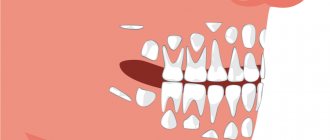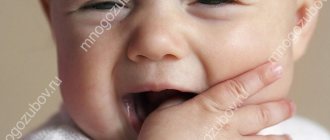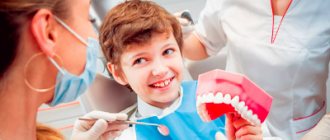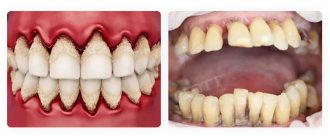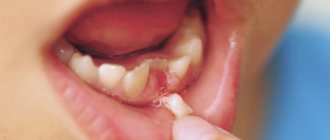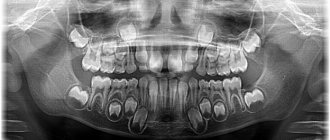The replacement of baby teeth with permanent ones usually takes place without any problems. However, many parents worry that some processes may go wrong. Therefore, they regularly monitor the condition of the baby’s teeth. Some people wonder how to distinguish a baby tooth from a permanent one, especially when it comes to molars. Indeed, when a child is 9-10 years old, this can become a problem - the incisors have already come out and there are no problems with them, but there is confusion with the distant teeth. How to learn to distinguish between them - let's figure it out together.
Content:
- Is there a difference? 2.1. Dairy 2.2. Indigenous
- How to tell the difference?
- Is there always a change?
- Are there baby wisdom teeth?
- Can milk root remain in the gums?
- When does radiography come to the rescue?
Children's milk and permanent teeth raise many questions from their parents.
The most attentive mothers and fathers try to clearly monitor the change in temporary bite. It happens that they do not understand whether the baby’s milk units remain in the baby’s mouth or are no longer there. How to determine whether a molar or baby tooth is? To do this you need to have certain information.
Anatomy of molars
There are three parts to a molar: The crown is the protruding part of the tooth. The root is that part of the tooth that is located under the gum and is held in the jaw bone with the help of connecting bundles. There can be several or one root in a tooth, it all depends on the specific tooth. The neck is the narrowest part of the tooth, located between its root and crown. The top of the tooth is covered by enamel - the hardest and most durable part of the tooth. After the baby’s tooth has erupted, it is covered with cuticle on top of the enamel - a thin transparent layer, which after some time is replaced by a film called pellicle. At the base of the tooth is dentin, which is covered with cement in the root area. Inside the tooth there are root canals and pulp, which is loose tissue filled with blood vessels and nerve endings.
Is there a difference?
It happens that, trying to determine which children have milk teeth, mothers make a significant wave of their hand and say that there are no differences between the new and old units. In fact, they are.
Dairy
They take their places for closer to two to three years. The very first ones erupt when the baby is 6-12 months old. There are only twenty primary teeth (while there are 32 primary teeth). Therefore, they are arranged in a row quite freely. As the jaw grows, the spaces between them increase significantly. This can be seen with the naked eye.
At the age of 5-6 years, temporary teeth begin to loosen and fall out. This process is completed by the age of 10-12 years.
Indigenous
They appear at five or six years old or a little later. First, molars grow , which become “sixes”. After this, the incisors begin to wobble. They are pushed out by a constant shift.
Children with permanent dentition usually have 28 teeth. The four terminal units (which are popularly called “wise”) usually appear after 20 years. For many, it grows at 30-40 years old. And this is the norm.
Where do teeth come from?
Teeth are formed in the fetus’s body during the mother’s pregnancy. When a mother abused something and undermined her own health, the subsequently born child was guaranteed to have diseased teeth that were no longer permanent. At the 15th week of pregnancy, the mother has hardened dental tissues in the fetus - starting from the crown area and ending with the root zone. The embryos of molar teeth are formed by the 5th month of fetal life. The body of a developing fetus and child is designed in such a way that in the upper jaw the anlage of the permanent teeth is located above the anlage of the milk teeth, and in the lower jaw - vice versa. The formation and development of teeth begins as early as the sixth week of fetal development. The source for them is a special epithelial dental plate. Already by 14 weeks of pregnancy, the unborn baby is actively forming hard dental tissues, initially in the area of the coronal part, and then in the area of the roots of the tooth. When a child is born, primary teeth are the first to grow - by the end of the child's first year of life, they will erupt. However, the dentition contains a group of large molars - they, in turn, do not have milk predecessors and subsequently, when they fall out, grow “on a permanent basis”. Nature has arranged it in such a way that while the child’s jaws are still too small, large molars are not needed there.
How to tell the difference?
It is possible to determine which “generation” a tooth belongs to by its:
- Size and shape. Molars are larger, because they are designed for the jaw of an adult. Their edges and boundaries are clear and lumpy. Dairy ones have rounded, smooth edges.
- Blossom. Children's units are white with a bluish tint, adults are yellowish-gray. This is due to the fact that the latter has a higher percentage of mineralizing components. Over the years, they also turn white, but at first they don’t look very presentable.
- Position in the oral cavity. The molars face towards the lips and cheeks. They appear to be slightly tilted. Dairy plants grow evenly and straight.
If we talk about the differences in more detail :
- Six and seven are always radical. You need to count from the middle line of the row (located between the central incisors) towards the ear. In the milk row there are only fives, since there are ten teeth at the bottom and at the top.
- If you have questions regarding the fours and fives, then maximum attention should be paid to their form. Primary teeth have wide crowns and chewing cusps (usually four). If a change has already occurred, then there will be fewer tubercles and the crown will be narrow.
- Temporary fangs are smaller than permanent ones. By the time they fall out, their sharp tips become dull. Instead, units with clearly pointed apexes grow.
- When assessing the nature of the incisors, you need to look at the size. In dairy ones, the width is about 4 mm, the height is 5-6. Permanent ones are usually larger. During the period of change of bite, children's incisors have smooth, even edges, while adults' incisors are lumpy.
Number of baby and molar teeth in a person
There are ten baby teeth on each jaw: four incisors, two canines, four molars. By the time baby teeth are replaced by permanent teeth, the child’s jaw reaches the size of an adult jaw and can already accommodate all 32 molars. On the upper and lower jaws there are two canines, four incisors, two premolars and three molars. To make it more convenient to describe the number of teeth in a patient’s oral cavity, dentistry uses a special dental formula, according to which each tooth is assigned its own number, according to its jaw location. Milk teeth are designated as follows:
- Incisors – I and II
- Fang - III
- Molars – IV and V.
- Molars are counted from the center to the sides:
- Incisors – 1 and 2
- Fang – 3
- Premolars – 4 and 5
- Molars – 6,7,8.
To understand on which jaw, as well as on the right or left, a tooth is located, another number is indicated before its number:
- Right side from top – 1
- Left side from above – 2
- Bottom left side – 3
- Bottom right side – 4.
That is, if, for example, a person is missing a lower wisdom tooth on the right side, it will be number 48 in the dental formula.
Is there always a change?
Not a single child's tooth should be preserved - they all fall out. Instead of each temporary one, a permanent one is cut through. But it also occurs in dental practice that the rudiment of the root unit is missing. This can be seen in the X-ray of the jaws.
In this case, the life of the baby tooth is extended to the maximum - after all, nothing will grow in its place. When an empty space appears in the dentition, the issue of prosthetics is discussed.
To eliminate partial congenital edentia, you can implant an implant or install a dental bridge. In the first case, there is no need to file adjacent teeth. The doctor, under local anesthesia, installs an artificial titanium root into the jaw tissue. When it takes root, it fixes the dental crown.
In the case of a bridge, it is necessary to depulpate and prepare the neighbors . This is not very healthy, since their service life after such manipulations is significantly reduced. Therefore, young patients who do not have separate molars are recommended by dentists to resort to implantation.
Adults also have milk “long-livers”
Yes, this is indeed possible. Milk teeth, which have a different structure and difference from permanent ones, may well be preserved in the bite of an adult. Whether to remove them, save them or replace them with prosthetics - this must be decided by the doctor depending on the clinical situation. For example, if they do not have the rudiments of permanent units under them, then you can simply improve the shape and aesthetics of the crown part so that they do not stand out in size against the background of their full-fledged “neighbors.” Read more about this phenomenon in the feature article on the website.
Can milk root remain in the gums?
If you carefully examine fallen children's teeth, you will not be able to see any semblance of roots. Some mothers unknowingly begin to panic - it seems to them that a significant part of the unit remains in the deep tissues of the gums.
There is no need to worry - this is how it should be. The absence of roots is the result of their gradual resorption. This process starts long before the day of loss. That is why during a natural change (when a tooth falls out without outside help), the child does not experience pain.
On a note
You should not go to extremes and see any toothache as a serious disease of the internal organs. It could be ordinary caries and nothing more. After all, the cause of caries can be many different or a combination of several factors: past infectious diseases, stress, lack of microelements, metabolic disorders.
The listed symptoms only indicate that different systems of the body are interconnected. Moreover, this connection can also be the opposite: an infection from a diseased tooth can easily be transferred into the body with food and saliva. Damages often affect the cardiovascular system (increased blood pressure), the excretory system (the appearance of trophic skin disorders, increased sweating), and in some cases the nervous system.
During inflammatory processes in the teeth (caries, pulpitis), pain appears so acute that the person immediately grabs the pills and the pain goes away. It turns out that the signal from the diseased organ was never noticed. And the process of destruction does not slow down, foci of chronic infection arise, which can be a source of more serious disorders in the body (sometimes this can even result in a heart attack, meningitis, sinusitis). In order for the body to work smoothly, you need to contact the dentist in a timely manner. And at the same time, we should not forget that after treating a diseased tooth, it is advisable to examine the organs associated with it.
When does radiography come to the rescue?
Very rarely, but still situations occur in dental practice when even the doctor doubts which tooth he has to work with - a child’s or a molar. In this case, the capabilities of radiography are used. In the photographs you can see:
- length and structural features of the roots;
- presence/absence of radical primordia;
- the location of the unerupted unit and the direction of growth of its incisal edge.
If you need to find out exactly what the situation is with a change in bite in a child, contact your dentist. He will tell you the number of units that should fall out in the near future, and tell you whether it is worth interfering with this process.
Disorders during the eruption of primary teeth
The most common timing for the eruption of baby teeth is listed above. It is optimal when, upon reaching the age of three, the child has a full set of primary teeth. If baby teeth erupt late, experts advise parents not to worry unnecessarily: a delay of 2 to 3 months is considered normal. If after this period the teeth do not appear, then you should consult a doctor who will examine the child’s oral cavity, take tests and take panoramic photographs of the jaw, after which it will be possible to draw certain conclusions about the reasons for this delay. This usually occurs due to a lack of minerals and vitamins, which is easily solved with the help of restorative therapy. It is much worse when the rudiments of baby teeth are simply absent. This occurs extremely rarely and is usually caused by genetic abnormalities, periodontal inflammation and mechanical damage. In this case, to properly distribute the chewing load and develop the jaw bones, it is necessary to wear a removable denture.

